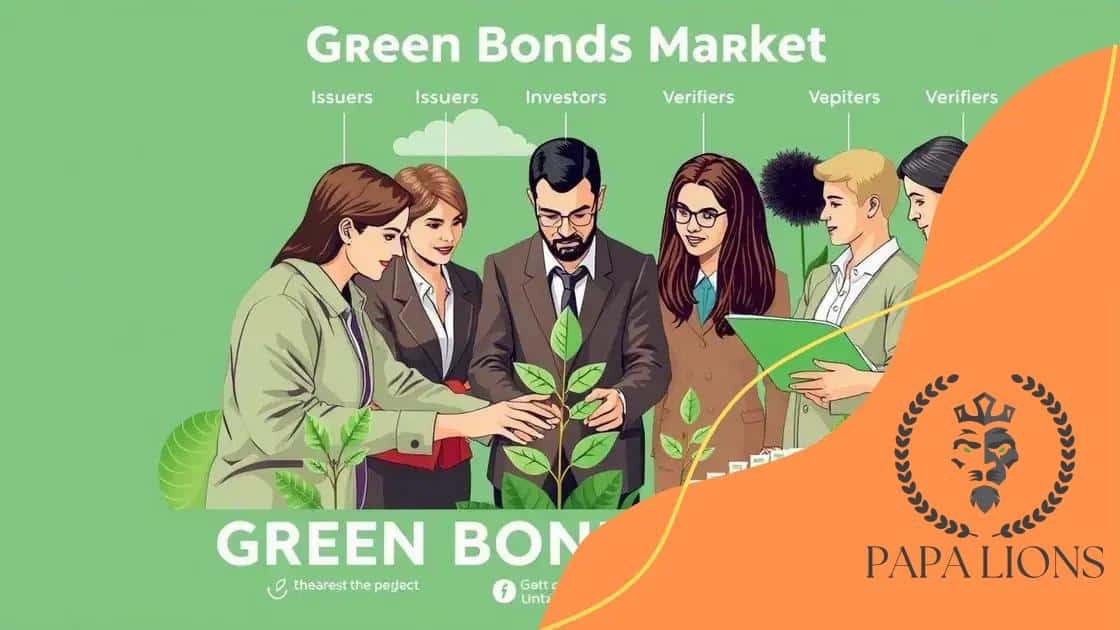Green bonds market growth: a promising investment

The green bonds market is rapidly evolving, driven by increased investor demand, innovative bond structures, and growing regulatory support, positioning them as key financial tools for funding sustainable projects.
Green bonds market growth is capturing the attention of investors worldwide. With a rising emphasis on sustainability, these financial instruments promise not only returns but also a positive impact on the environment. Have you considered how investing in green bonds could benefit both your portfolio and the planet?
Understanding green bonds: an overview
Understanding green bonds is essential for anyone interested in sustainable investments. These financial instruments are designed to fund projects with positive environmental impacts. They are a key part of the growing green finance movement, as they offer a way to support eco-friendly initiatives while earning returns.
What are green bonds?
Green bonds are fixed-income securities that raise capital for projects aimed at improving the environment. This includes renewable energy, energy efficiency, clean transportation, and sustainable water management. Investors are attracted to these bonds because they can align their financial goals with their values.
Key characteristics of green bonds include:
- They fund projects that provide environmental benefits.
- They are issued by various entities, including governments, municipalities, and corporations.
- They come with a specific framework that outlines how the funds will be used.
Why invest in green bonds?
Investing in green bonds not only supports sustainability but can also be financially rewarding. With the increasing importance of climate action, companies and governments are more focused on green projects. This focus creates a favorable environment for growth in the green bonds market.
By choosing green bonds, you contribute to:
- Reducing carbon emissions.
- Promoting renewable energy sources.
- Encouraging sustainable practices across industries.
In essence, green bonds are not just a financial tool; they represent a commitment to a sustainable future. Investors can make a difference while still achieving their investment goals. Take the time to explore how green bonds can fit within your portfolio.
The role of green bonds in sustainable finance
The role of green bonds in sustainable finance is becoming increasingly important. These financial instruments serve as a bridge between traditional investors and environmentally beneficial projects. By investing in green bonds, individuals and institutions can contribute to a more sustainable economy.
How green bonds contribute to sustainable projects
Green bonds are specifically aimed at funding initiatives that offer environmental benefits. Such projects include renewable energy installations, energy efficiency improvements, and sustainable agriculture practices. This focus makes them an attractive option for investors who want to make a positive impact.
Investing in green bonds can lead to significant benefits, such as:
- Support for climate change mitigation efforts.
- Funding for innovations in clean technology.
- Encouragement of sustainable practices in various industries.
The impact on investor behavior
As more investors seek to align their portfolios with their values, green bonds have gained traction. This shift in investor behavior is evident, as many now prefer investments that contribute to sustainability. By choosing green bonds, investors not only pursue financial returns but also support global efforts to combat climate change.
Moreover, the demand for green bonds has created a competitive marketplace. This competition drives issuers to provide better terms, making green bonds even more appealing. Investors can achieve high returns while being part of a solution-oriented finance system.
In summary, the integration of green bonds into the finance sector represents a significant development in the pursuit of sustainability. With their ability to fund environmentally-friendly initiatives, they play a crucial role in the transition toward a more sustainable and resilient economy.
Key players in the green bonds market

The green bonds market involves several key players who contribute to its growth and effectiveness. Each of these participants plays a vital role in ensuring that green bonds fulfill their purpose of financing environmentally-friendly projects.
Issuers of green bonds
Issuers are organizations that create and sell green bonds to raise funds. They include:
- Governments at various levels, including federal, state, and local.
- Corporations seeking to finance sustainable initiatives.
- Multilateral development banks that support global environmental projects.
These issuers are crucial as they define the projects funded by the bonds. They must provide a clear framework explaining how the proceeds will be used, ensuring transparency.
Investors
Investors are essential for the success of the green bonds market. They include
- Institutional investors, such as pension funds and insurance companies.
- Retail investors interested in sustainable finance.
- Impact investors who seek to generate social or environmental impacts alongside financial returns.
These investors are attracted to green bonds because they align their investment choices with their values, supporting projects that contribute to a healthier planet.
Third-party verifiers
To foster trust in the green bonds market, third-party verifiers assess the environmental benefits of projects financed by green bonds. They review and validate
- the usage of proceeds from the bonds,
- the sustainability claims made by issuers, and
- compliance with established standards.
These verifiers enhance credibility in the market, reassuring investors that their money is genuinely supporting green initiatives.
In summary, the green bonds market is supported by various players, each with distinct roles. By working together, issuers, investors, and third-party verifiers contribute to a vibrant market that fosters sustainable development.
Challenges and risks in green bond investments
Investing in green bonds offers many benefits, but there are also challenges and risks that investors should understand. Acknowledging these factors can help individuals and institutions make informed decisions.
Market volatility
Like any investment, green bonds are subject to market fluctuations. While they aim to provide stable returns, uncertain economic conditions can impact their performance. Investors may experience price changes based on shifts in interest rates and market sentiment.
Project integrity
Another risk involves the actual projects funded by green bonds. Sometimes, the environmental benefits promised may not materialize as anticipated. The effectiveness of the projects can be influenced by factors such as:
- Changing regulations.
- Technological challenges.
- Project mismanagement.
Due diligence is crucial in assessing the credibility of the projects associated with green bonds. Investing without proper evaluation can lead to disappointing results.
Lack of standardization
The green bonds market lacks universally accepted standards, causing confusion for investors. Different issuers may use varied criteria to define what qualifies as a “green” project. This inconsistency makes it harder for investors to compare options and gauge the true impact of their investments.
Investors should seek bonds with clear and transparent disclosures related to the use of proceeds and the environmental impact intended. This helps ensure that their investments align with their sustainability goals.
In conclusion, while green bonds present an exciting opportunity for sustainable investment, investors must navigate potential risks. By being aware of market volatility, project integrity issues, and the lack of standardization, they can better position themselves for success in the green bonds market.
Future trends in the green bonds market
The future trends in the green bonds market are shaping up to be exciting and transformative. As awareness of climate change grows, more investors are looking for sustainable options, making green bonds an attractive choice for financing eco-friendly projects.
Increased investor demand
One key trend is the increasing demand from both institutional and retail investors. Many are now prioritizing sustainability, driving more funds into green bond investments. This shift is prompted by both a desire for responsible investing and recognition of the long-term benefits of supporting sustainable initiatives.
Innovation in green bond structures
Another trend is the innovation in bond structures. Financial institutions and issuers are developing new types of green bonds, including:
- Hybrid green bonds that combine features of different financial instruments.
- Green bond funds that pool multiple issuers.
- Sustainable linked bonds that tie financial performance to sustainability targets.
These innovations help attract a wider range of investors and make it easier to finance diverse green projects.
Regulatory support and frameworks
As the market matures, regulatory support is expected to grow. Governments and regulatory bodies are likely to establish clearer frameworks and guidelines for green bonds. This will enhance transparency and accountability, ensuring that funds are used for genuine sustainable projects.
Stronger regulations can help mitigate risks associated with “greenwashing,” where companies misrepresent their sustainability efforts. By creating stringent standards, investors can feel more secure about where their money is going.
Ultimately, the outlook for the green bonds market is promising. With growing demand, innovative structures, and regulatory support, we can expect this market to play a significant role in funding a sustainable future.
FAQ – Frequently Asked Questions about Green Bonds
What are green bonds?
Green bonds are fixed-income securities specifically issued to finance projects that have positive environmental impacts, such as renewable energy and sustainable infrastructure.
How do green bonds contribute to sustainability?
By investing in green bonds, investors help fund projects that reduce carbon emissions, promote renewable energy, and support sustainable practices, contributing to a healthier planet.
What risks should I be aware of when investing in green bonds?
Investors should consider market volatility, project integrity, and the lack of standardization in the green bonds market, which can affect the expected outcomes.
What trends should investors watch for in the green bonds market?
Key trends include increasing investor demand, innovation in bond structures, greater regulatory support, and a focus on transparency and accountability.





